AMD A10-5800K & A8-5600K Review: Trinity on the Desktop, Part 2
by Anand Lal Shimpi on October 2, 2012 1:45 AM ESTContent Creation Performance
Adobe Photoshop CS4
To measure performance under Photoshop CS4 we turn to the Retouch Artists’ Speed Test. The test does basic photo editing; there are a couple of color space conversions, many layer creations, color curve adjustment, image and canvas size adjustment, unsharp mask, and finally a gaussian blur performed on the entire image.
The whole process is timed and thanks to the use of Intel's X25-M SSD as our test bed hard drive, performance is far more predictable than back when we used to test on mechanical disks.
Time is reported in seconds and the lower numbers mean better performance. The test is multithreaded and can hit all four cores in a quad-core machine.
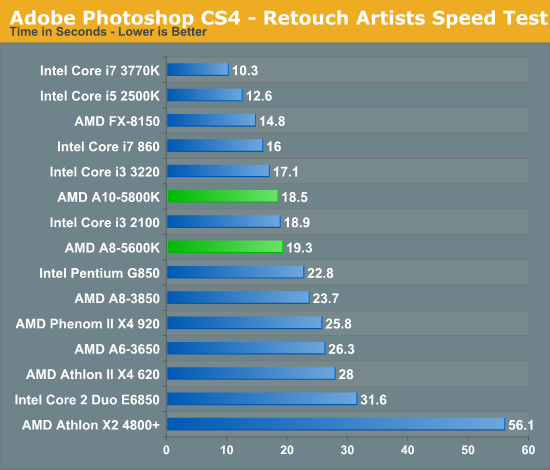
Our Photoshop workload still runs better on Intel hardware, but the gap in performance between the 5800K and 3220 is smaller than it was between the FX-8150 and 2500K last year. While Bulldozer was pretty much unrecommendable, Trinity approaches tradeoff territory.
3dsmax 9 & POV-ray
Today's desktop processors are more than fast enough to do professional level 3D rendering at home. To look at performance under 3dsmax we ran the SPECapc 3dsmax 8 benchmark (only the CPU rendering tests) under 3dsmax 9 SP1. The results reported are the rendering composite scores.
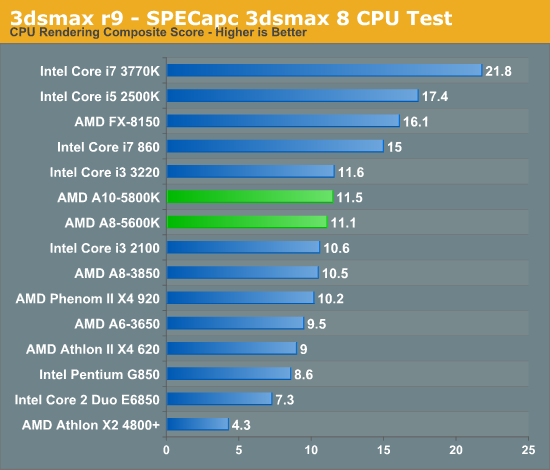
Once again in a heavily threaded FP benchmark, the A10 and Core i3 perform very similarly. POV-Ray is another example of this below:
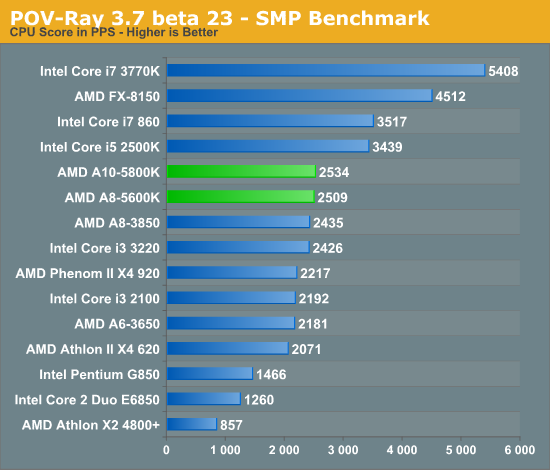
File Compression/Decompression Performance
Par2 is an application used for reconstructing downloaded archives. It can generate parity data from a given archive and later use it to recover the archive
Chuchusoft took the source code of par2cmdline 0.4 and parallelized it using Intel’s Threading Building Blocks 2.1. The result is a version of par2cmdline that can spawn multiple threads to repair par2 archives. For this test we took a 708MB archive, corrupted nearly 60MB of it, and used the multithreaded par2cmdline to recover it. The scores reported are the repair and recover time in seconds.
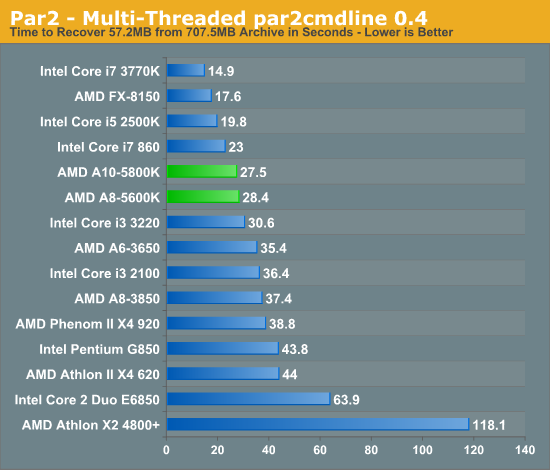
Our multithreaded Par2 recovery test shows AMD with a small advantage over the Core i3 3220, although it obviously can't touch any of the more expensive quad-core parts.
Excel Math Performance
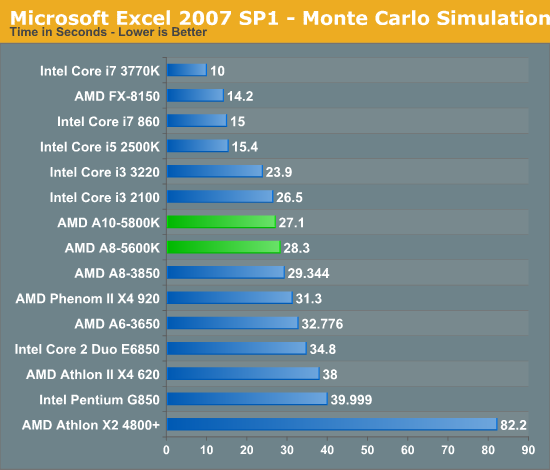
Not all heavily threaded FP applications are easy wins for AMD. In our Monte Carlo simulation benchmark the 3220 manages a decent lead over the A10-5800K.
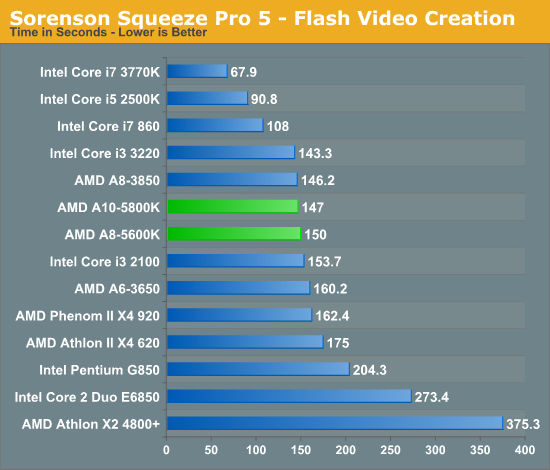
Our old Sorenson Squeeze test is one area where we see a slight regression compared to Llano. Like I mentioned earlier, this isn't super common but it does happen from time to time given the dramatic architecture difference between Llano and Trinity.










178 Comments
View All Comments
amd4evernever - Sunday, October 14, 2012 - link
http://www.tomshardware.com/reviews/a10-5800k-trin...choke on this..... read first before trolling.. you intel lunatic.
Spunjji - Tuesday, October 2, 2012 - link
Agreed. Ignoring all troll comments that followed this post...C1377 - Friday, July 5, 2013 - link
Just purchased the a10-5800k with a Motherboard for a net cost of $140. Can't beat that price... The Over/Under clock ability is the ace in the hole, as is power consumption when gaming (compared to a discrete graphics solution). For those of us who don't need to game at higher resolutions than 1080p, this setup is great.Beyond that All I need in performance is the ability to encode DVD's faster than my DVD burner, and handle file compression... most of us do work on pc's purchased by our company, and at home we do things like photoshop and DVD authoring. Sometimes I think you guys get so engrossed in the technicalities, that you forget the real world scenarios. How much time am I going to save by the "huge phenominal difference" of 77-70 fps on a DVD encode? I am still going to spend 15-20 minutes burning the DVD, so is a processor which costs an extra $50 worth the shaving down my DVD creation time from 45 min to 42.06783 min? Is this really a "huge phenominal difference" ...only on benchmarks--not in the real world.
gamoniac - Tuesday, October 2, 2012 - link
Anyone who still has not switched to Intel and has AMD's previous high-end chips (eg Phenom II x6) most likely has a high-end graphic card as well, so it makes little sense to switch to a Trinity APU unless one is building a new system or HTPC. I think this fact is hurting AMD, too.Besides that, with AMD having to pitch their top Trinity APU against Intel's i3 chips, I think it is time for AMD to stop any artificial market segmentation on their side. Instead, just make as many high-end APU they can for each TDP bracket and sell them at lower prices. The economies of scale might help bring A10-5800K down to $100, then they would stand a chance against Intel until Excavator cores are out in a couple of years. I don't know... Just a thought. It's painful to see how far the single-thread performance is at this point and Haswell is not even out yet.
fteoath64 - Tuesday, October 2, 2012 - link
Agreed!. AMD should be selling many variants of this APU at different prices. In fact, since Trinity is so highly clocked, it makes the Llano look better, I am gunning for a A8-3870 llano which is just a tab slower than A10-5800 but if Llano can be clocked to 3.3Ghz or 3.5Ghz then it would be a real cracker for the price yet it idles at just as low power consumption. To me, AMD has not made progress since Trinity is highly clocked compared to Llano. If a Llano hits 3.8Ghz, it would blow away the top-end A10 chip which is an embarrassment. We need to compare frequency as well to make clock-for-clock improvements (if any, I can see very few). So, this is why Trinity was artificially delayed to get the Llano parts moving. I can see these Llano parts moving quicker now that the benches are out for all to see.Medallish - Tuesday, October 2, 2012 - link
I don't get your logic, Llano will sell better now that Trinity is out and it's better? No one really cares about clock for clock, there are three major factors here, Price, power, and performance.A10-5800K comes at around the same price and performs better than Llano A8-3870 in pretty much every way.
A10.-5800K uses on average less power than A8-3870, while delivering better performance.
If I buy an APU it's usually based on two factors, CPU and GPU performance, on both of these it's better than Llano while staying within price and power of the previous Llano flagship.
Let me put it in another way, if Haswell turns out to run 4GHz to achieve same speed as a 3GHz Ivy Bridge, but it cost the same, and used 20% less power, would you care at all?
My Desktop is still running Phenom II, I plan on upgrading to Vishera once it's released, no one expected Trinity to be an upgrade for exsisting Enthusiasts using AMD systems, unless they're running something even older and just want something average. Where I plan on using Trinity is in an HTPC. If Iwanted a workstation I think Trinity would make a lot of sense, it sort of makes it all around in terms of work space tasks. For my gaming PC obviously I would stick with a higher end Desktop configuration, but that's not to say that Trinity can't work, we did see gaming reviews last week using a dedicated 7870 and still keep up once the graphics details were pushed.
mikato - Wednesday, October 3, 2012 - link
"...unless one is building a new system..."Uh, isn't this 90%+ or something of CPU purchases? Actually building a new system (for my parents) and maybe an new HTPC (for me) is exactly why I'm interested.
Paulman - Tuesday, October 2, 2012 - link
I just realized that an emerging use case for gamers is live-streaming (or even Fraps'ing) themselves while they play. I'd imagine that's a use case that makes more use of multiple cores, since most games these days only really stress two or so cores?What do you think about eventually introducing a live streaming / video encoding benchmark to represent that use case? (I'm most familiar with Xsplit, as that's what most of the gamers and broadcasters I watch [on Twitch.tv] use)
elhoboloco - Tuesday, October 2, 2012 - link
You should try FFSplit. It's so much easier!Ryan Smith - Tuesday, October 2, 2012 - link
It's worth noting that the moment someone introduces a live streamer with support for Intel's QuickSync and AMD's VCE video encoders, such a benchmark would be made redundant. Those fixed function encoders are designed in large part around real time encoding and completely offload the process, so bogging down the CPU to do real time encoding has effectively been rendered obsolete.